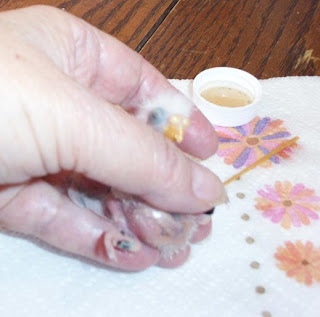If you allow your tame birds to fly free, be aware of potential hazards. Here are photographs of the hazards in our home that we try to stay aware of.
When we built our home, and chose the lighting fixtures, we didn’t keep birds. Now we do. To keep our birds safe, overhead lights with exposed bulbs like these are turned off and allowed to cool before we release any birds to fly. This includes when I’m handfeeding youngsters outside their cage. Some have been known to fly off even before all their feathers are in! All they need is the will, a few wing feathers, and a loose hold by me.
You should already know that hot stoves are a high risk. As a child, I remember my grandfather’s yellow budgie, Goldie, who had crippled feet from landing on his hot frying pan. She recovered, but her feet were never the same. Make sure all burners are off and cooled before you release your birds. Even though you might be in another room, if doors are open, they could fly anywhere!

Windows are the most likely risk to birds. We’ve tried to cover our windows with curtains or blinds so that birds won’t fly into them. However, the laundry room has a large window that isn’t covered. The master bath also has windows that are open, as shown. The frosted pictures help prevent wild birds from flying into them, but small parakeets like ours might decide to fly through the areas that aren’t frosted. I close all doors with access to either of these rooms before allowing any of our birds to fly free.

The biggest hazard in our home is two small windows in the peak of the living room. Covering them would be a problem. Fortunately, our tame birds seldom go up that high, but I’ve had youngsters head for them. We have a disabled male Splendid whose wing never healed correctly after flying at full speed into a window. We call him “Flip” because whenever he attempts to fly, he flips. He has lots of toys and sticks to climb, but it would be so much better if he’d never injured his wing. It happened on his first solo flight when he escaped while being transferred from his parents’ cage to another cage with his siblings. Now, he lives in a large cage with “retired” Bourkes and one other bachelor Splendid (who I’d like to find a hen for, by the way).
We have three cats and a big dog … any of whom could dispatch a bird in quick order. However, we’ve spent time training the cats and dog to leave the birds alone, and they do. Yet, we’re careful to never leave the birds alone with them over night.
Admittedly, we do run outside for a few minutes without any concern for the birds’ safety while cats sleep on a nearby couch or chair. We even forgot and left one of the cats asleep in a window seat once, and were gone from home for 8 hours with no harm done.
I honestly don’t think the birds would be at risk, but why take chances? Our cats and dog sleep elsewhere at night…away from any access to the birds.
It is important to train your pets to accept one another though. We’ve had three instances where a baby bird escaped from me and flew over a cat (or all three), even landing in front of one of them. When that has happened, our cats freeze. They know they’d be in trouble if they hurt the bird. Even the old stray cat we adopted leaves the birds alone. She appreciates being taken in. My kitties amaze me, but if animals love their owners (or fear reprisals?), they can be trained to behave as you want them to.
If you haven’t already, go through your home and identify potential risks to your birds. Better to be prepared. Luck and Love …
 did find some copies still available at Amazon. If you love animals, this will make you see bats in a whole new light. This woman rescued a tiny bat off a hot sidewalk without actually touching it. After all, we don't consider bats as safe animals, do we? It changed her life, she ended up with an affectionate pet, and has made bats her interest ever since.
did find some copies still available at Amazon. If you love animals, this will make you see bats in a whole new light. This woman rescued a tiny bat off a hot sidewalk without actually touching it. After all, we don't consider bats as safe animals, do we? It changed her life, she ended up with an affectionate pet, and has made bats her interest ever since. 
























